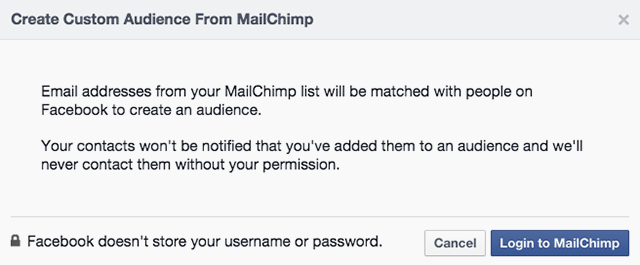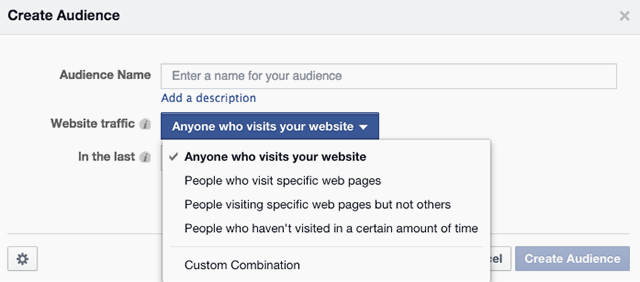Advanced Guide for Advertising on Facebook

Facebook Advertising is always a hot topic – as evidenced by the great conversation our recent Beginner’s Guide to Facebook Ads prompted. The article discussed how to choose the best campaign objective and ad placement, but glossed over the idea of choosing who to actually advertise to.
An advertisement is worthless if it doesn’t reach the right people. Thus, we wanted to provide a guide for targeting those Facebook ads through the network’s Power Editor.
Getting Started with Power Editor
To kick off the process, open your Facebook ads account and find the link to the Power Editor on the left hand side of your dashboard. Once there, navigate to the Manage Ads box in the upper left hand corner and choose Audiences.

From the Audiences page in the Power Editor navigate to the “Create Audience” button, which allows you to create a new Facebook advertising audience using one of three segmenting styles.

- Facebook Custom Audiences
- Facebook Lookalike Audiences
- Facebook Saved Target Groups
- Facebook Targeted Ad Example
Facebook Custom Audiences
Facebook Custom Audiences give you a secure way to import customers from other sources to then target on Facebook. There are currently four ways to import customers from other sources – Facebook’s Data File Custom Audience, MailChimp Custom Audience, Custom Audience from an App and Website Custom Audience.
1. Facebook’s Data File Custom Audience
This function enables you to upload your own spreadsheet of customer data so that Facebook can cross-reference it with information they have on file to find matches and create a target audience.

There are currently four different types of data that Facebook will accept.
Email Addresses
There’s a good chance that you have a list of prospects’ email addresses that you’d like to target on social. Just upload the list of emails and if any of those email addresses match one on file for a user, that user will be put into a custom audience.
Facebook User IDs
Facebook User IDs are essentially unique identifiers given to each person by the site. There are a handful of ways to find out someone’s user ID for targeting purposes, but make sure you do it ethically; it’s against Facebook’s terms of service to scrape user IDs.
Phone Numbers
Typically a sales team will have a CRM system full of phone numbers that could make prime social targets. That’s why it’s key to keep the communication channels open between sales and online marketing departments.
Mobile Advertiser IDs
Mobile Advertiser IDs are ways application developers can identify who is using their mobile app. They can then use that information to go on to create advertisements targeted to those users. Sometimes advertisers get nervous about infringing upon their customers’ data privacy, but it should be known that Facebook encrypts your data before uploading it. You can read all about the terms of service for custom audiences here.
2. MailChimp Custom Audience
If you have a MailChimp account, you can use it to import email lists to Facebook. Once you log into your MailChimp account through Facebook, you’ll have the option to import any or all of your email lists to the site for targeting. The prompt assures you that your leads will not be notified they’re being put on a targeting list.

3. Custom Audience from an App
This feature can be a powerful way to create hyper-targeted audiences for businesses with their own apps. Not only can you create an audience based on every person who accesses your app, but you can get even more granular by targeting people who reach a certain part of the app, such as a high level in a game.
4. Website Custom Audience (aka Facebook Retargeting)
Also known as Facebook retargeting, Website Custom Audiences are easily the most powerful of the Facebook Custom Audience features. By placing a Facebook pixel on your site, you will be able to track your visitors back to Facebook where you can retarget them with a custom advertisement. You can even refine the custom audience to target people who have visited certain pages, not visited certain pages, or a combination of the two.

For example, you could create an audience that will target someone who has checked out your product’s features but never made it to the purchase page.
Facebook Lookalike Audiences
Now that you’ve combined your own data with Facebook, it is time to look for new potential customers. With Facebook Lookalike Audiences, you can upload one of your current audience segments and Facebook will use its own algorithm to find users who are similar to the people in that group.

There are three different audience sources you can create a lookalike from:
Custom Audiences
These can be based on email addresses, Facebook user IDs, phone numbers, and mobile advertiser IDs.
Conversion Tracking Pixel
This is a specific type of pixel for your page that will only trigger when someone accomplishes a goal, like clicks a particular button or makes a purchase.
Page
If you’re a Page admin, you can create a lookalike audience based on your Page’s current following. Once you pick an audience source, choose the country you want the new users to live in and decide if you want to optimize for similarity or reach. The former choice will find fewer people who are more closely related to the original group, while the latter will find more people who are not as closely related.
Facebook Saved Target Groups
This type of user targeting is much more conventional. Facebook has a plethora of information on all of its members and this is the place to come to take advantage of that. Here are just a few of the many segmenting capabilities Facebook has for their saved target groups:
Custom Audiences
Facebook Saved Target Groups has the amazing ability to upload one of your custom audiences so that you can continue to refine the targeting around that segment. For example, you can upload a big list of emails that you want to target, then continue to refine that audience by adding on different parameters like age, gender, or location.
Excluded Audiences
This is the ability to upload a custom audience to a saved target group, but instead of serving the ad to those users, Facebook will make sure to not show the ad to those people. So if your campaign objective is to bring completely new visitors to your site, you can choose to exclude a list of people who have visited your web page in the past.
Life Events
Facebook has a unique way of finding people who have experienced, or are about to experience, important life events. This includes things like an approaching anniversary, someone celebrating a new job or someone celebrating a new relationship. This is a great way to target customers if your product fits into any of these categories.
Categories
This data is interesting because it comes from third parties sources Acxiom, Datalogix, and Epsilon. The companies that provide this information actually base it on information collected on other websites, which is why it would definitely be worth testing out.
Connections
This capability is great because it will allow you to solely target users connected to your Page, so you have a good idea that they already like your brand. You can also choose to target people not already connected to your Page, which can boost your reach to unique users.
Facebook Targeted Ad Example
We’re now going to walk through an example of creating an ad and targeting it using a custom audience, a Lookalike audience, and a saved target group. Imagine the sales team of your company just sent over a list of about 700 customers who you would like to target with Facebook ads in hopes of bringing them back to your site to buy more products.
Step 1. Upload the List of Potential Customers’ Email Addresses
You need to upload the file in the audiences tab of Power Editor. All of the email addresses must be in the first column and the document must be saved as a .txt or .csv file. When you upload the file in Power Editor you should see a prompt similar to this:

The 727 instead of 730 mean that three of the email addresses weren’t uploaded due to errors, most likely formatting mistakes. Facebook will now go to work pairing the emails that did upload properly.
Step 2: Create a Lookalike Audience
Facebook finished matching as many emails as it could and we ended up with a segment of 400 users, which doesn’t seem high enough for this campaign. That’s why we should create a Lookalike audience to supplement this group. Open up the Lookalike Audience section and choose the correct source, what you named the email list in step one, then choose a target country and level of similarity.

We chose to optimize for high similarity because we don’t want this list of very relevant emails to be watered down with people who don’t fit. This Lookalike yielded an additional 2.1 million users to target.
Step 3: Additional Targeting by Demographics
Now that we have a sizable audience pool, we can start to layer on some additional targeting parameters. For instance, we can cut the audience down by adding an age restriction, location, or interests. That’s what we did for this example, and we went from an audience of more than 2.1 million users down to 30,000 very relevant targets.

Testing for Continued Success
As you can see, there are many different ways to find audiences to advertise to on Facebook. The key is to keep testing new ways to find which one will drive the lowest cost per goal and which will be the most effective. If you’re not quite ready to start your foray into paid Facebook advertising solutions, don’t worry. There are some great tools out there – like our own Sprout Social – that can help you maximize your organic engagement with your customers.
The post Advanced Guide for Advertising on Facebook appeared first on Sprout Social.





0 comments:
Post a Comment